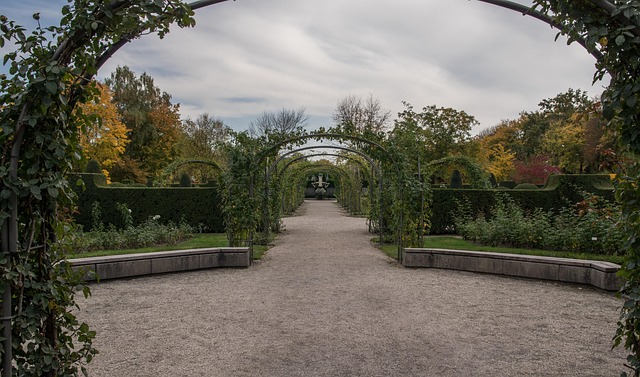Plant support trellises are essential garden tools, offering structural assistance to heavy vines, climbers, and decorative plants. They come in diverse designs catering to specific plant needs—from robust metal/wooden structures for heavy vines to flexible mesh trellises for climbing vegetables. Choosing the right material and pattern ensures optimal growth and enhances garden aesthetics. Key considerations include strength, durability, and maintenance requirements. Proper installation, regular care, and seasonal maintenance guarantee a trellis's longevity, supporting various climbers with robust support.
Explore the transformative power of garden trellises, engineered for robust support, perfect for heavy vines, climbing vegetables, or ornamental plants. This comprehensive guide delves into the pivotal role of plant support trellises, offering insights on diverse trellis types tailored to specific plant needs. From design considerations fostering optimal growth to material and construction techniques, we provide installation, maintenance, and long-term care tips for ensuring your trellises withstand the test of time.
Understanding the Role of Plant Support Trellises
Plant support trellises play a vital role in gardening, especially when it comes to heavy vines, climbing vegetables, or decorative plants that require extra structural assistance. These trellises offer maximum support, enabling plants to grow vertically and thrive. By providing a framework for plants to lean on, trellises help distribute the plant’s weight evenly, preventing damage caused by excessive stretching or twisting. This is particularly beneficial for climbers like ivy, roses, and wisteria, which can otherwise strain fences, walls, or existing structures.
Moreover, plant support trellises enhance overall garden aesthetics. They add a decorative element to outdoor spaces, creating an attractive visual as plants grow upwards. Trellises also allow for efficient use of vertical space, making the most out of limited areas. Whether in a backyard, greenhouse, or even indoor gardens, these structures ensure that plants reach their full potential, fostering robust growth and beautiful displays.
Types of Garden Trellises for Various Plants
Garden trellises come in various types, each designed to cater to different plant needs and preferences. For instance, heavy vines like wisteria or ivy require robust structures that can withstand their weight and provide ample space for growth. These plants benefit from sturdy metal or wooden trellises with strong horizontal or diagonal supports.
Climbing vegetables such as cucumbers or beans need a more flexible option, often in the form of mesh or woven wire trellises. These allow plants to wrap around them naturally while providing adequate support. Decorative plants, on the other hand, may require intricate designs that blend into their aesthetic appeal, with options like ornate metal or wood trellises adding an elegant touch to any garden setting.
Design Considerations for Efficient Plant Growth
When designing or selecting a garden trellis for efficient plant growth, consider factors like material strength and flexibility to accommodate heavy vines, climbers, or ornamental plants. Metal trellises, often crafted from sturdy aluminum or iron, offer exceptional durability and can withstand the weight of mature plants. Their rigid structure ensures plants receive consistent support, encouraging robust growth without the risk of collapse.
Additionally, thoughtful design elements like triangular or mesh patterns enhance airflow and sunlight penetration, fostering a healthier environment for your plants. These intricate designs not only provide adequate plant support trellises but also add aesthetic appeal to your garden landscape.
Choosing the Right Materials and Construction Techniques
When selecting materials for your garden trellises, consider factors like strength and durability to ensure they can handle the weight of heavy plants. Metal trellises, often made from aluminium or steel, offer exceptional strength while being resistant to rust and decay. Wooden options, typically crafted from cedar or treated timber, provide a natural aesthetic and good support but require regular maintenance. For a more versatile choice, synthetic materials like PVC composite offer durability against elements and UV rays without corrosion concerns.
Construction techniques also play a key role in the effectiveness of plant support trellises. Look for designs with robust connections between the frame and supports to prevent warping or breaking under strain. Wrought iron and forged metal trellises often feature intricate, interlocking joints that provide exceptional stability. Modular trellis systems offer versatility, allowing you to customize configurations while ensuring each section is securely connected. Proper assembly and regular maintenance will maximize the lifespan of your chosen plant support trellis.
Installation, Maintenance, and Long-Term Care Tips
Installation:
Begin by choosing the ideal location for your trellis, considering the plant’s sun and moisture needs. Dig a hole or prepare a base to anchor the trellis securely. Follow the manufacturer’s instructions for assembly; most plant support trellises are easy to put together with simple tools. Ensure all components are tightly connected for stability. When installing, consider the growth pattern of your vines or plants; some may require additional training to encourage upward growth.
Maintenance and Care:
Regular cleaning is essential for long-term use. Remove debris and dead plant matter at the end of each growing season to prevent pest or disease issues. Check the trellis structure periodically, tightening any loose joints or replacing worn-out parts as needed. Pruning is also vital; trim excess growth from plants to keep the trellis organized and ensure optimal air circulation. This simple maintenance routine will keep your plant support trellises functional for years, providing robust support for a diverse range of climbing flora.
Garden trellises are a gardener’s secret weapon, offering structured support for plants that climb or trail. By selecting the right type of trellis for your heavy vines, climbing vegetables, or decorative plants, you can create a thriving vertical garden. Understanding the specific needs of your plants and choosing the appropriate design, materials, and installation techniques will ensure optimal growth and long-lasting beauty. Equip yourself with this knowledge, and let plant support trellises transform your outdoor space into a verdant masterpiece.
